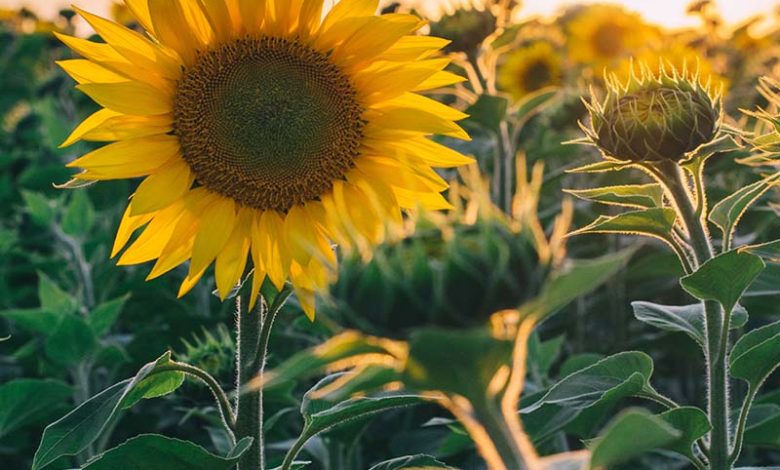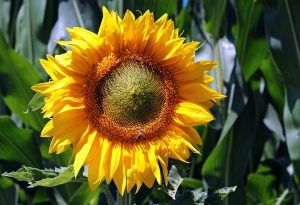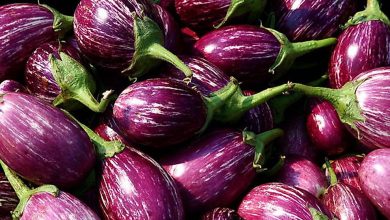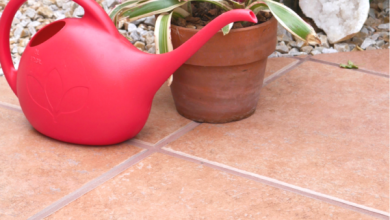Plant Sunflowers: [Cultivation, Care, Irrigation, Substrate, Pests]

 Sunflowers are among the most striking and characteristic flower species in the world.
Sunflowers are among the most striking and characteristic flower species in the world.
With their dark center and yellow petals that open prodigiously to greet each new day, they are capable of adorning any environment.
Your plant can be planted in pots or directly in the garden, enjoying in both cases the beauty that it transmits.
Do you want to plant sunflowers in your garden and see how their flowers revolve around the sun?
In the following article we show you the most important points that you must take into account for the correct cultivation of sunflowers
Important points when planting sunflowers
- When? In spring.
- Where? In a place with access to sunlight, it can be in a garden or pot.
- How do we prepare the land? With a good amount of organic matter.
- How should we water? With little water because it does not get along withexcessive humidity.
- How often do you have to water? Once or twice a week, as the soil dries out.
- What pests and diseases does it have? Caterpillars, larvae and fungi that are generated from high humidity.
When to plant sunflowers?
 The ideal time for planting sunflowers is when winter is over and spring days are already well under way.
The ideal time for planting sunflowers is when winter is over and spring days are already well under way.
This is a species that gets along well with hot climates and it is necessary to offer it appropriate temperatures for the seeds to germinate.
Where to plant a sunflower?
The sunflower can be sown directly in the garden or in a pot, but it must be considered that its flowers have a considerable height and space must be given to them.
This height, in some cases, is capable of reaching up to 2 meters, so if you have it in a pot in a place with air plants, they may collide.
You also have to take into account that it needs to receive a good amount of sunlight a day because it is part of its vitality cycle.
How to prepare the land for growing sunflowers?
 The sunflower gets along better with soils that are well nourished, so it is advisable to apply fertilization prior to planting.
The sunflower gets along better with soils that are well nourished, so it is advisable to apply fertilization prior to planting.
This can be done with manure and after planting, when it has a certain size, apply it again.
It is also necessary to clear the planting area of weeds to prevent them from depleting the available nutrients in the soil.
Regarding the texture of the land, it is necessary that the drainage is at appropriate levels, since it is a species that does not tolerate waterlogging.
For this reason, specialists recommend that it lean more towards the sandy than the clayey.
How do we water?
Irrigation is necessary to work it with precision, taking advantage of a watering can to place the amount of water that is needed.
It is better not to apply so much water that it leads to waterlogging because this can cause stains on the stems.
How often do we water sunflowers?
The most recommended thing is that the irrigations are carried out once or twice a week depending on the amount of heat that exists.
If temperatures are low and evaporation is not so high, it can be reduced to 1 weekly watering.
How to plant sunflowers step by step?
- Sunflower sowing is done through the seeds, which are the easiest to germinate.
- To advance in this process, the following steps must be followed:
- After having prepared the ground with enough organic matter, select the space where the seed will be placed.
- Bury the seed and cover with a thin layer of soil over it, enough so that it does not blow away if there is a current of wind. Ideally, the seed should be about 7 cm deep.
- When the seedling is growing, it may be necessary to help it with a support that allows it to stand upright without complications. It is a species that grows tall and does not have such a solid base as in the case of trees. This action is especially useful in places where the wind is very strong and could affect it.
- Water with enough water to moisten the soil throughout this growth stage, ensuring that the soil dries out before applying the next irrigation session.
- The germination of the sunflower in seedbeds is also possible, but it must be taken into account that it creates a family of very wide roots. This condition demands greater attention to the exact moment of transplantation to prevent them from drowning in such a small space.
And if the transplant is going to be done in a pot, it must be large enough to allow it to be comfortable at the base.
What care do you need?
 As we have already seen, providing a good amount of organic matter will help it grow healthier and bloom better.
As we have already seen, providing a good amount of organic matter will help it grow healthier and bloom better.
In addition, sunflower pruning is generally done to remove the flowers that will be used for other purposes, such as interiors.
Being a plant that does not grow with many branches and whose leaves tend to be few, another type of pruning is unnecessary.
What pests and diseases affect the sunflower?
In relation to diseases, the most common is that it is attacked by fungi that are produced from excessive humidity in its environment.
Therefore, it is a preventable condition with the correct application of irrigation and the use of natural products such as horsetail extract.
Regarding pests, caterpillars are the species that most tend to affect sunflowers, especially when they are still young plants.
Thanks to Bacillus Thuringiensis, both the caterpillars and the larvae (if they appear) can be controlled without major inconveniences.
Sunflower plantations are not only for ornamental use, although it is a fact that they already offer very good results in this respect.
It is a plant that is also harvested for industrial uses, as is the case for the manufacture of oils, cosmetics and even medicinal products.
Sunflower seeds are very valuable in the kitchen because they can be eaten toasted or added to different preparations.
All this has given the sunflower a leading role in the lives of many farmers around the world.
verticillium wilt
 Verticillium or Verticillium wilt is a common soil fungus that thrives in temperate climates around the world and can be present in the soil for decades.
Verticillium or Verticillium wilt is a common soil fungus that thrives in temperate climates around the world and can be present in the soil for decades.
Verticillium wilt overwinters in the soil as dormant mycelium or tiny dormant black structures called microsclerotia, waiting for favorable conditions to return.
They enter damaged plant tissue through the roots and multiply. Many common weeds, such as dandelions and weeds, can be Verticillium host species.
Verticillium wilt is a disease that affects more than 350 species of eudicolous plants. It is caused by six species of Verticillium fungi: Verticillium dahliae, Verticillium albo-atrum, Verticillium longisporum, Verticillium nubilum, Verticillium theobromae, and Verticillium tricorpus.
Many plants with significant economic weight are susceptible, such as cotton, tomatoes, potatoes, oilseed rape, aubergines, peppers, and ornamental plants, as well as others in natural vegetation communities.
Many species and cultivars of eudicots are resistant to the disease, and all monocots, gymnosperms, and ferns are immune. To know more: Verticillium wilt in the Orchard: What is it? How do we identify it?



![Photo of How to Prune an Avocado Tree: [Guide on Avocado Tree Pruning]](https://www.complete-gardening.com/wp-content/uploads/2022/08/how-to-prune-an-avocado-tree-guide-on-avocado-tree-pruning-390x220.jpg)
